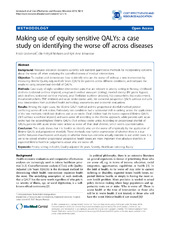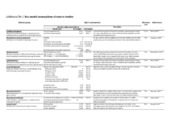| dc.contributor.author | Lindemark, Frode | en_US |
| dc.contributor.author | Norheim, Ole Frithjof | en_US |
| dc.contributor.author | Johansson, Kjell Arne | en_US |
| dc.date.accessioned | 2014-09-05T09:59:56Z | |
| dc.date.available | 2014-09-05T09:59:56Z | |
| dc.date.issued | 2014-07-23 | eng |
| dc.identifier.issn | 1478-7547 | |
| dc.identifier.uri | https://hdl.handle.net/1956/8422 | |
| dc.description.abstract | Background: Resource allocation decisions currently lack standard quantitative methods for incorporating concerns about the worse off when analysing the cost-effectiveness of medical interventions. Objective: To explore and demonstrate how to identify who are the worse off without a new intervention by measuring lifetime Quality-Adjusted Life Years (QALYs) for patients across different conditions, and compare the results to using proportional shortfall of QALYs. Methods: Case study of eight condition-intervention pairs that are relevant to priority setting in Norway; childhood deafness (unilateral cochlear implant), unruptured cerebral aneurysm (coiling), morbid obesity (RY gastric bypass), adult deafness (unilateral cochlear implant), atrial fibrillation (catheter ablation), hip osteoarthritis (hip replacement), rheumatoid arthritis (TNF inhibitor) and acute stroke (stroke unit). We extracted prospective QALYs without and with new interventions from published health technology assessments and economic evaluations. Results: Among the eight cases, the lifetime QALY method and the proportional shortfall method yielded conflicting worse-off rank orders. Particularly two conditions had a substantial shift in ranking across the applications of the two methods: childhood deafness and acute stroke. Deaf children had the lowest expected lifetime QALYs (38.5 without a cochlear implant) and were worst off according to the lifetime approach, while patients with acute stroke had the second-highest lifetime QALYs (76.4 without stroke units). According to proportional shortfall of QALYs, patients with acute stroke were ranked as worse off than deaf children, which seems counterintuitive. Conclusion: This study shows that it is feasible to identify who are the worse off empirically by the application of lifetime QALYs and proportional shortfalls. These methods ease further examination of whether there is a true conflict between maximization and equity or whether these two concerns actually coincide in real world cases. It is yet to be solved whether proportional prospective health losses are more important than absolute shortfalls in expected lifetime health in judgements about who are worse off. | en_US |
| dc.language.iso | eng | eng |
| dc.publisher | BioMed Central | eng |
| dc.rights | Attribution CC BY | eng |
| dc.rights.uri | http://creativecommons.org/licenses/by/2.0 | eng |
| dc.subject | Priority setting in health | eng |
| dc.subject | Quality-adjusted life years | eng |
| dc.subject | Severity | eng |
| dc.subject | Healthcare rationing | eng |
| dc.subject | Equity | eng |
| dc.title | Making use of equity sensitive QALYs: a case study on identifying the worse off across diseases | en_US |
| dc.type | Peer reviewed | |
| dc.type | Journal article | |
| dc.date.updated | 2014-08-27T11:25:14Z | |
| dc.description.version | publishedVersion | en_US |
| dc.rights.holder | Frode Lindemark et al.; licensee BioMed Central Ltd. | |
| dc.rights.holder | Copyright 2014 Lindemark et al.; licensee BioMed Central Ltd. | |
| dc.source.articlenumber | 16 | |
| dc.identifier.doi | https://doi.org/10.1186/1478-7547-12-16 | |
| dc.source.journal | Cost Effectiveness and Resource Allocation | |
| dc.source.40 | 12 | |



